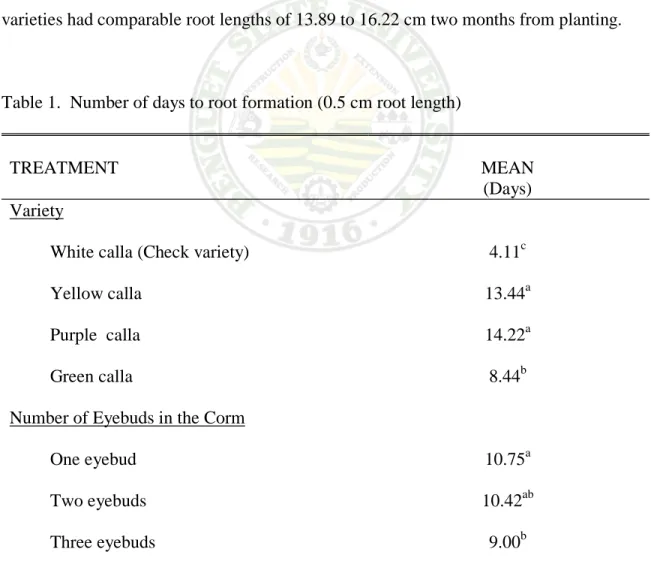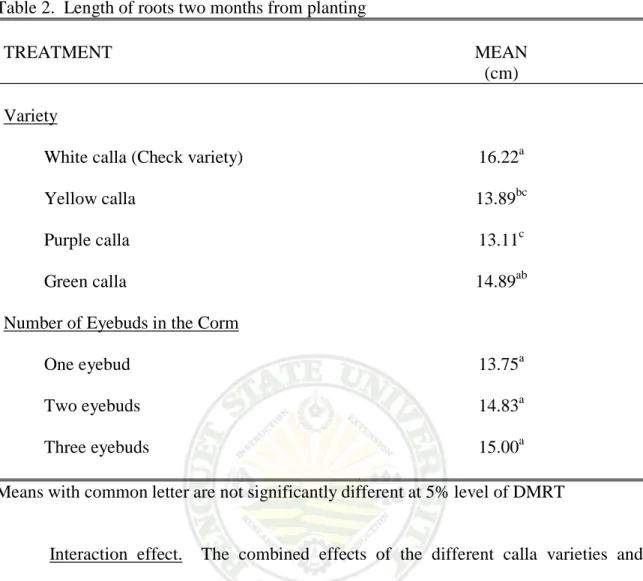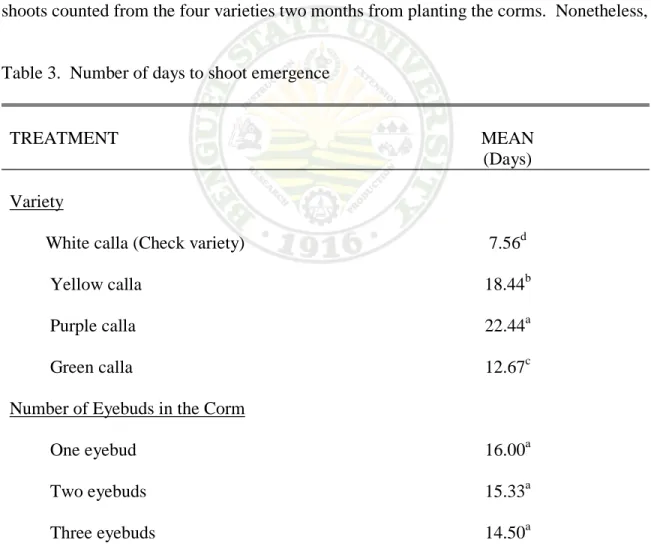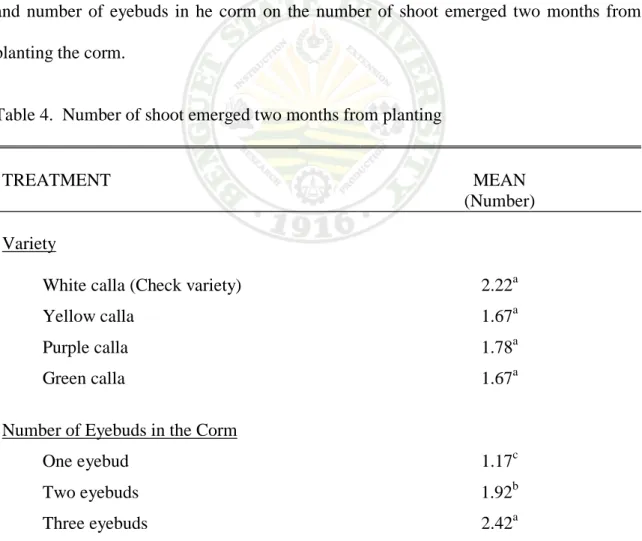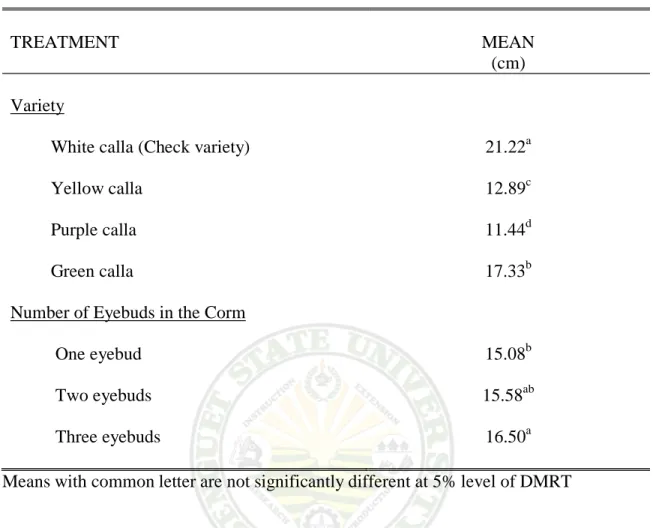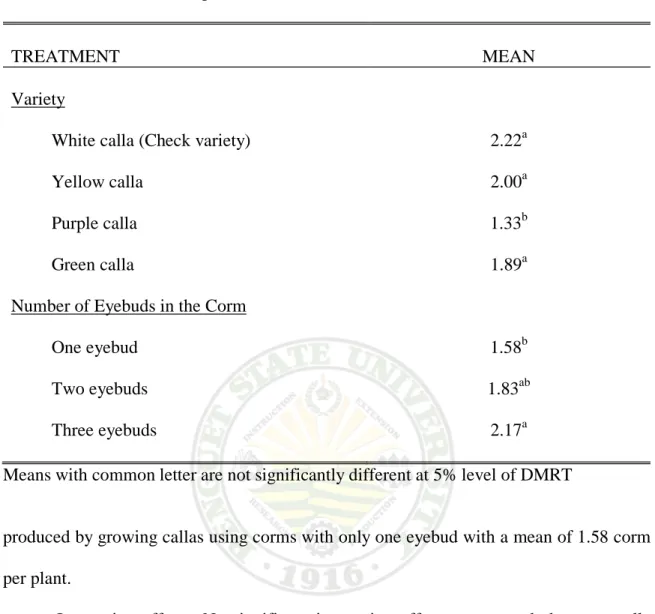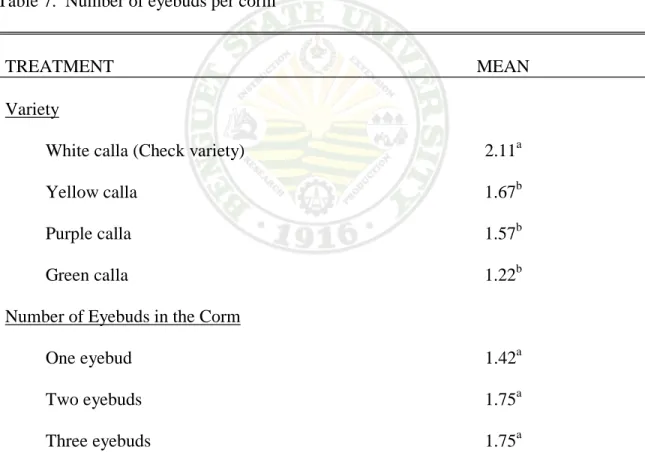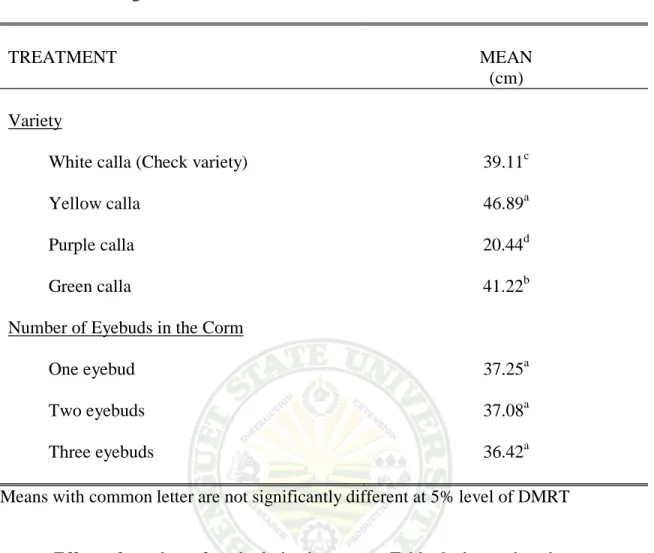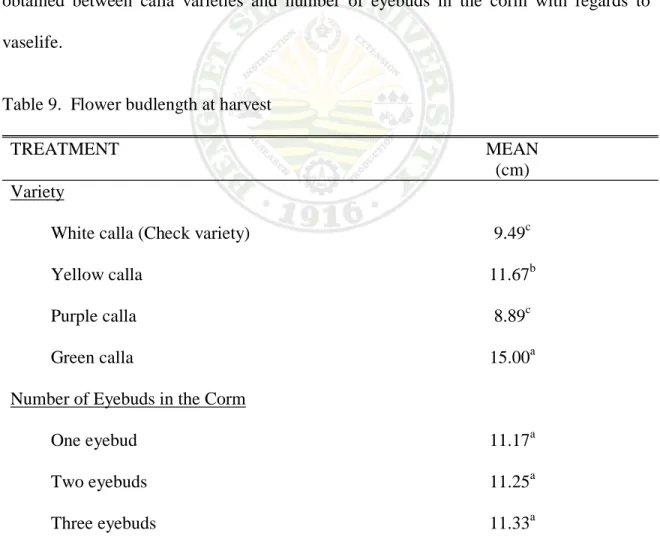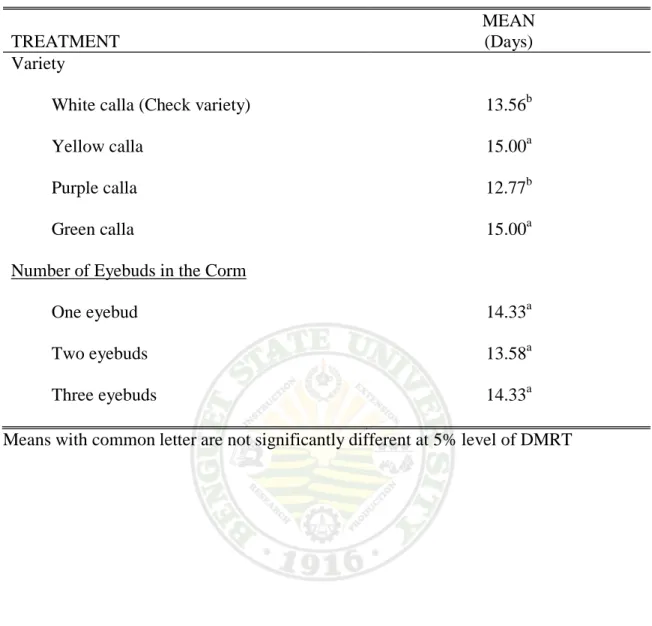TERCERO, KALYN A. October, 2008. Growth and Flowering of Colored Callas as Affected by the Number of Eyebuds in the Corm as Planting Materials.
Benguet State University, La Trinidad, Benguet.
Adviser: Fernando R. Gonzales, PhD.
ABSTRACT
This study was conducted at the Ornamental Horticulture Research Area, Benguet State University, La Trinidad, Benguet from September 2007 to March 2008, to determine the effects of the number of eyebuds in the corms as planting materials in colored calla lily, and the economics of using the different techniques in calla lily corm production.
Corms with different number of eyebuds were planted in the growing media of 1:1 alnus leaves compost + garden soil. The variety used were white calla (check variety), yellow callas, purple callas and green callas. Results revealed that white callas with three eyebuds in the corm were the latest to produce roots and had the longest roots and shoots and produced more shoots per plant two months from planting. There were no rotted corms in all the treatments observed. All the corms survived, two months from planting.
The calla lilies produced only one flower for the duration of the study. White calla with there eyebuds in the corm produced more corms per plant and with more eyebuds per corm.
flowering. Significantly, the green callas with three eyebuds produced the longest flower budlength at harvest (50% anthesis).
Corms with three eyebuds is therefore, recommended for better cutflower quality and its has longer vaselife.
Page
Bibliography. . . i
Abstract. . . . . . i
Table of Contents . . . iii
INTRODUCTION . . . 1
REVIEW OF LITERATURE The Plant Characteristic . . . Propagation . . . 3 3 Planting . . . 4
Irrigation . . . 4
Light Requirement . . . 4
Soil Requirements . . . 5
Climatic Adaptability . . . . . . 5
Variety Evaluation . . . 5
Cutflower Characteristics . . . . . . Vaselife and Longevity of Cutflowers . . . 6 6 MATERIALS AND METHODS Materials . . . 7
Method . . . . . . 7
RESULTS AND DISCUSSION Number of Days to Root Formation . . . 10
Number of Days to Shoot Emergence . . . 12
Number of Shoot Emerged . . . 13
Shoot Length . . . . . . . . . 15
Percentage of Survival . . . .. . . . 15
Number of Rotted Corms . . . 16
Percentage of Rotted Corms . . . 16
Number of Flower per Plant. . . 17
Number of Corms per Plant . . . . 17
Number of Eyebuds per Corm . . . 18
Stem Length of Cutflower at Harvest . . . 20
Flower Budlength at Harvest . . . 20
Vaselife . . . .. 21
SUMMARY, CONCLUSION AND RECOMMENDATION Summary . . . . . 28
Conclusion . . . 29
Recommendation . . . . . . . . . 29
LITERATURE CITED . . . 30
APPENDICES . . . 31
INTRODUCTION
Calla Lilies are unique and elegant flowering plant that make a spectacular addition to the home garden. They are also very popular for bridal bouquets and cutflower arrangement. White calla are quite common, it is referred to as the local indigenous calla lily that are grown in Cordillera. These plants are also available in an array of beautiful colors including shades of green, pink, purple, yellow and orange.
Calla Lily of the genus Zanthedeshia belong to the family Aracea. It is more closely related to caladium and does not have the same habit and cultural requirement as found in the liliums. There are six known species of the genus such as Z. aethhipica, the common white calla lily; Z. elliottiana, the yellow calla; Z. albumaculata, the cream flowers; Z. pentlandii, deciduous or gold; Z. rehmanii, the pink and purple calla; and Z.
jucanda, deciduous flower and spotted, but not use horticulturally.
Growing colored calla can be develop as a profitable business in Baguio and Benguet. Production of calla lilies as one of the flower industries can contribute to the economy of the country. It is a good source of income for our flower growers. However, only few flower growers in the Cordillera do the production because of expensiveness of the rhizomes or corms as a planting material. Growers save the rhizomes and corms from the previous plant for the next cropping.
Rhizome division is the most common propagation method used in calla lily, but varies depending on the species.
In the view of point seen in calla lily production, this study aims to help the calla lily growers to determine the effect of number of eyebuds in colored calla lily corm and it’s effect in the cutflower yield and vaselife. Further, this study will help the students,
teachers and farmers to serve as guide for them, as the future reference on the growth and flowering of calla lily as affected by number of eyebuds in the corms as planting materials.
This study was conducted at the Ornamental Horticulture Research Area, Benguet State University, La Trinidad, Benguet from September 2007 to March 2008 to determine the effect of the number of eyebuds in the corm on the growth and flowering of colored calla; and its effect on the cutflower yield and vaselife.
REVIEW OF LITERATURE
The Plant Characteristics
Calla Lily of the genus Zanthedeshia belongs to the family Aracea. It is more closely related to caladium and does not have the habit and cultural requirements as found in true liliums.
There are six known species of the genus such as Z. aethiopica, which is a robust plant with thick stems carrying large, broad, fleshy dark green leaves. Grown commercially in Benguet in large quantities; Z rehmannii bear flowers ranging in color pink to wine red; Z. albumaculata, deciduous, cream flowers; Z elliottiana has yellow or golden flower and tall stems from early summer. It has a heart shaped, dark green, upright leaves which are covered with translucent white spots; Z. pentlandii deciduous or gold and Z. jucanda,, deciduous yellow and spotted, but not use horticulturally.
Cutflower yield is dependent on cultivar, tuber size and growth regulator applications. One to three flowers can be expected from 1 -5 centimeters diameter tuber.
The flowers are green at macobud stage and gain full color upon opening. After pollination flowers often deepen on the color, begin to regreen and close (Rimando, 2001).
Propagation
On the propagation of colored calla lily, the most common used is by rhizomes and division (Larson, 1980).
Propagation of the species can be done by seed, although this propagation is limited to the true species, which have limited color range. Division of tubers after lifting
is a common means increasing initial stock numbers. This type of propagation should not be sustained for longer than two to three years as it is a very conducive method over the spread of viral and bacterial (Welsh and Baldwin, 1986).
Planting
Plant calla lily tubers, 2” deep with the developing shoots pointed upward (Garden Calla Lily Information”).
Planting depth and density is widely dependent on size of tubers and expected duration in the ground. Tubers should have twice their depth of soil on top once the planting hole is covered (Rimando, 2001).
Irrigation
After planting, water is sparingly until leaves are unfurled. Provided soil and good drainage, generous amount of water can be applied and during flowering period.
Once flowering complete, irrigation may be reduced to minimize bacterial soft viruses incidence (Rimando, 2001).
Light Requirement
Calla Lilies planted outdoors grow best – they require full sun to partial shade, depending on the climate.
Full sun encourages brighter and richer calla lily bloom color. In warmer climates through they should be planted in partial shade to avoid temperatures (Garden Calla Lily Information).
Soil Requirements
Calla Lily tubers require a loose, well draining soil (Garden Calla Lily Information). It grows in moist provided they have adequate drainage. Sandy loams are preferred as in additions to having good drainage makes lifting of the tuber easier.
Moreover, tubers are easier to clean than those in sticker soils. Soil PH should be adjusted to 6.0 – 6.5 (Rimando, 2001).
Climatic Adaptability
Janick (1972) stated that climate, the summation of and areas weather which involves temperature, moisture and light effect are the factors whose actions and interactions must be considered in the physical environment of plants. This can be determined when where the plant will grow.
Callas prefer warm weather with the daytime temperature of between 70-75oF and cooler nights around 55°F.
Variety Evaluation
Edmund and Andrew (1964) said that varieties differ in productivity as expression of hereditary genes influenced by the environment. According to Villareal and Wallace (19 ), the variety best adapted by the environment reflects the high yield potential.
Growth and yield of foliage depends on the interaction between the environmental factors and practices applied on them. Each plant has characteristics such as color, leaf shape, size and growth rate that determine its potential for consumer satisfaction (Manaker, 1981). Botangen (1983) reported that the heights of the different varieties from each other presumably because of varietal characteristics.
Morfe (1980), stated that there are varieties to give good results. They may not vary latest but there are varieties which will not fail to make good plant and flower.
There is a good selection of colors and lots of them are plant suitable for the show bench.
Most of these will flower the whole year under growing conditions.
Cutflower Characteristics
According to Baldwin and Welsh (1986), calla lily flower stem height is between 60-90 cm for premium grade cutflowers. Shorter stemmed flowers (30-40 cm) can be used as “posy arade” at a lower price. Flower quantity is dependent on cultivar/specie, tuber corm size and growth regulator application, one to three flowers can be expected from a 4-5 cm diameter (2 – inch tuber).
Vaselife and Longevity of Cutflowers
Temperature is the major factor affecting the storage and vaselife of flowers. This is through its influence on the respiration rate of the flowers, their response to ethylene, moisture loss and damage (Anonymous, undated).
Emilio (1996), stated that the rate of the respiration has a bearing on the longevity of any cutflowers.
MATERIALS AND METHODS
Materials
The materials used in the study were the corms of 4 varieties of colored calla lilies, greenhouse, plastic bags, 1:1 garden soil + alnus leaves compost and labeling materials.
Methods
This study was arranged in Factorial Completely Randomized Design (CRD) with the four varieties of colored calla lily as factor A and the number of eye buds in the corm as factor B. There were three replications per treatment combination. All sample plants were given the same maintenance and management routine operation practices such as irrigation, crop protection and fertilizer applications.
The treatments were as follows:
Factor A: Calla Lily Variety Treatment Code Variety
V1 White calla Zanthedeshia aethiopica V2 Yellow calla Zanthesdia elliottiana V3 Purple calla Zanthedesdia rehmanii V4 Goddess green calla Zanthesdia aethipica
Factor B: Number of Eye Buds in the Corm T1 – 1 eyebud
T2 – 2 eyebuds
T3 – 3 eyebuds
The data gathered were as follows:
1. Number of days to root formation. This was taken by counting the number of days from planting the corms in the rooting media to root formation.
2. Length of roots (cm). This was taken by measuring the length of the roots after 2 months from planting.
3. Number of days to shoot emergence. This was taken by counting the number of days from planting to shoot emergence.
4. Number of shoots emerged. This was taken by counting the number of shoots that emerged from the corm.
5. Shoot lengths (cm). This was taken by measuring the length of the shoots produced after 2 months from planting.
6. Percentage (%) survival. This was obtained by using the following formula:
Percentage of survival = Number of corm survived_____ x 100 Total number of corms planted
7. Number of rotted corms. This was taken by counting the number of rotted corms after 2 months from planting in the growing media.
8. Percentage (%) of rotted corms. This was obtained by following the formula Percentage of survival = No. of rotted corm/single line_x100
Total number of corms planted 9..Yield
a. Number of corms. This was taken by counting the number of corms produced per plant.
b. Number of flower. This was taken by counting the number of flower produced per plant for the duration of the cropping period.
10. Cutflower quality
a. Stem length at harvest (cm). This was taken at 50% anthesis.
b. Flower bud length at harvest (cm). This was taken at 50% anthesis.
c. Vaselife. This was taken by counting the number of days of aesthetic value from placing the cutflowers in the vase up to the onset of senescence.
11. Documentation of the study through pictures.
RESULTS AND DISCUSSION
Number of Days to Root Formation
Effect of variety. Table 1 presents the number of days to root formation (0.5 cm long) as affected by the different varieties used. Among the four varieties, white calla lily plants were the earliest to produce roots with a mean of 4.11 days. This was followed by green calla lily with a mean of 8.44 days; while, yellow and purple calla lilies were the latest to produce roots with comparable means of 13.44 days and 14.22 days, respectively.
Effect of number of eyebuds in the corm. Significant differences were likewise observed among the three propagation materials used which are the number of eyebuds in the corm, as shown in table 1. Growing callas with three eyebuds in the corm significantly produced the earliest roots with a mean of 9.00 days from planting which had least number of days to produce roots, but was statistically comparable to those grown from corms with two eyebuds with a mean of 10.42 days. Significantly delayed root formation was noted in corms with only one eyebuds which had a mean of 10.75 days.
Interaction effect. No significant interaction effects were observed between the calla varieties and number of eyebuds in the corm on the number of days to root formation.
Length of Roots
Effect of variety. Significant differences were obtained in the length of roots measured two months from planting the corms of the different varieties. White calla lily
corms produced the longest roots with a mean of 16.22 cm but was statistically comparable to green calla lily which had a mean 14.89 cm. Slightly shorter roots were measured on yellow calla lily which had a mean of 13.89 cm. Purple calla lily had corm with a mean of 13.11 cm roots which the shortest roots measured among the four varieties growth.
Effect of number of eyebuds in the corm. Table 2 shows that there were no significant differences noted on the length of roots measured as affected by different propagation materials two months from planting. Nonetheless, three eyebuds present in the corm of planting produced the longest roots with a mean of 15.00 cm. The other varieties had comparable root lengths of 13.89 to 16.22 cm two months from planting.
Table 1. Number of days to root formation (0.5 cm root length)
TREATMENT MEAN
(Days) Variety
White calla (Check variety) 4.11c
Yellow calla 13.44a
Purple calla 14.22a
Green calla 8.44b
Number of Eyebuds in the Corm
One eyebud 10.75a
Two eyebuds 10.42ab
Three eyebuds 9.00b
Means with common letter are not significantly different at 5% level of DMRT
Table 2. Length of roots two months from planting
TREATMENT MEAN
(cm) Variety
White calla (Check variety) 16.22a
Yellow calla 13.89bc
Purple calla 13.11c
Green calla 14.89ab
Number of Eyebuds in the Corm
One eyebud 13.75a
Two eyebuds 14.83a
Three eyebuds 15.00a
Means with common letter are not significantly different at 5% level of DMRT
Interaction effect. The combined effects of the different calla varieties and number of eyebuds in the corm on length of roots two months from planting were not significant.
Number of Days to Shoot Emergence
Effect of variety. Table 3 presents the significant differences on the number of days to shoot emergence among the four varieties. White calla were the earliest to produce shoots with a mean of 7.56 days. This was followed by green calla with a mean of 12. 67 days then followed by yellow calla lily with a mean of 18.44 days.
Significantly delayed shoot emergence was noted on purple calla lily with a mean of 22.44 days.
Effect of number of eyebuds in the corm. There were no significant differences noted on the number of days to shoot emergence as affected by the different propagation materials used which are the number of eyebuds in the corm. Nonetheless, three eyebuds in the corm with a mean of 14.50 days had the earliest to produce shoots.
Interaction effect. The combine effects of calla varieties and number of eyebuds in the corm on the number of days to shoot emergence were not significant.
Number of Shoot Emerged
Effect of variety. There were no significant differences noted on the number of shoots counted from the four varieties two months from planting the corms. Nonetheless,
Table 3. Number of days to shoot emergence
TREATMENT MEAN
(Days) Variety
White calla (Check variety) 7.56d
Yellow calla 18.44b
Purple calla 22.44a
Green calla 12.67c
Number of Eyebuds in the Corm
One eyebud 16.00a
Two eyebuds 15.33a
Three eyebuds 14.50a
Means with common letter are not significantly different at 5% level of DMRT
white calla lily had higher number of shoots with a mean of 2.22, but was statistically comparable to the other varieties with a mean of 1.67 to 1.78 shoots per plant.
Effect of number of eyebuds in the corm. Statistical analysis showed that there were highly significant differences on the number of shoots emerged as affected by the different number of eyebuds in the corm. Three eyebuds in the corm produced more corms with a mean of 2.42. This was followed by two eyebuds in the corm with a mean of 1.92. The least number of shoot emerged was obtained in one eyebud in the corm with a mean of 1.17.
Interaction effect. There were no significant interaction between callus varieties and number of eyebuds in he corm on the number of shoot emerged two months from planting the corm.
Table 4. Number of shoot emerged two months from planting
TREATMENT MEAN
(Number) Variety
White calla (Check variety) 2.22a
Yellow calla 1.67a
Purple calla 1.78a
Green calla 1.67a
Number of Eyebuds in the Corm
One eyebud 1.17c
Two eyebuds 1.92b
Three eyebuds 2.42a
Means with common letter are not significantly different at 5% level of DMRT
Shoot Length
Effect of variety. Table 5 shows that significantly longer shoots were measured on white calla lily with a mean of 21.22 cm. This was followed by green calla lily with a mean of 17.33 cm. Slightly smaller shoots were measured in yellow calla lily with a mean of 12.89 cm. Shortest shoots were obtained from purple calla lily with a mean of 11.44 cm two months from planting the corm.
Effect of number of eyebuds in the corm. Significant differences were observed among the different propagation materials which are the number of eyebuds present in the corm. Three eyebuds in the corm had the longest length measured with a mean of 16.50 cm. Growing callas with only one eyebud in the corms produced the shortest shoots measured with a mean of 15.08 cm, but was statistically comparable to callas grown from corms with two eyebuds with a mean of 15.58 cm.
Interaction effect. The combined effects of calla varieties and number of eyebuds in the corm on shoot length two months from planting, did not differ significantly.
Percentage of Survival
Results revealed that there were no significant differences obtained on the percentage of survival as affected by calla varieties grown and the number of eyebuds in the corm two months from planting.
Growth and quality of plants depend on the interaction between environmental factors and practices applied on them (Manaker, 1981).
Table 5. Shoot length
TREATMENT MEAN
(cm) Variety
White calla (Check variety) 21.22a
Yellow calla 12.89c
Purple calla 11.44d
Green calla 17.33b
Number of Eyebuds in the Corm
One eyebud 15.08b
Two eyebuds 15.58ab
Three eyebuds 16.50a
Means with common letter are not significantly different at 5% level of DMRT
Number of Rotted Corms
Results shows that there were no rotted corms observed two months from planting the corms in the growing media as affected by calla varieties and number of eyebuds in the corm.
Percentage of Rotted Corms
Based on the results, there were no rotted corms calculated as affected by varieties and different numbers of eyebuds in the corm two months from planting.
Number of Flowers
Results revealed that only one flower was produced per plant for the duration of the study. Therefore, there were no significant difference recorded on the number of flowers per plant as affected by the calla varieties grown and number of eyebuds present in the corm.
Morfe (1980), mentioned that there were varieties that can be relied to give good results. They may not vary, but there are varieties which will not fail to make a good plant and flower.
Furthermore, Rimando (2001) stated that cutflower yield is dependent on cultivar, tuber, tuber size and growth regulator applications. One to three flowers can be expected from 4 - 5 centimeters diameter tuber in callas.
Number of Corms
Effect of variety. Table 6 shows the effect of varieties on the number of corms produced per plant. Significantly, white calla lily had the highest number of corms produced with a mean of 2.22, but was comparable to yellow and green calla lilies with a mean of 2.00 and 1.89. Purple calla lily produced the least number of corms with a mean of 1.33.
As Edmund and Andrews (1964) reported, the varieties differ in productivity as expression of hereditary genes influenced by the environment. The variety best adopted to environment reflects the high yield potential.
Effect of number of eyebuds in the corm. The effect of number of corms produced shown in Table. Propagation materials with three eyebuds in the corm significantly produced more corms with a mean of 1.83, lesser number of corms were
Table 6. Number of corms produced
TREATMENT MEAN
Variety
White calla (Check variety) 2.22a
Yellow calla 2.00a
Purple calla 1.33b
Green calla 1.89a
Number of Eyebuds in the Corm
One eyebud 1.58b
Two eyebuds 1.83ab
Three eyebuds 2.17a
Means with common letter are not significantly different at 5% level of DMRT
produced by growing callas using corms with only one eyebud with a mean of 1.58 corm per plant.
Interaction effect. No significant interaction effects were rated between calla varieties and number of eyebuds in the corm, with regards to the number of corm produced per plant.
Number of Eyebuds per Corm
Effect of variety. Significantly, white calla lily had the higher number of eyebuds produced in the corm with a mean of 2.11, compared to the other varieties. Statistical analysis shows the comparable number of eyebuds on yellow, purple and green calla lilies with means of 1.67, 1.56 and 1.22 respectively.
Effect of number of eyebuds in the corm. There were no significant differences recorded on the number of eyebuds produced in the corms lifted from the ground after flowering. However, growing callas with two eyebuds and three eyebuds in the corms produced more eyebuds per corm in the daughter corms with the same mean of 1.75 corms per plant. Shortest number of eyebuds was recorded on one eyebuds in the corm.
Interaction effect. No significant interaction effects were observed between calla varieties and number of eyebuds in the corms with regards to the number of eyebuds produced in the daughter corms after planting.
Table 7. Number of eyebuds per corm
TREATMENT MEAN
Variety
White calla (Check variety) 2.11a
Yellow calla 1.67b
Purple calla 1.57b
Green calla 1.22b
Number of Eyebuds in the Corm
One eyebud 1.42a
Two eyebuds 1.75a
Three eyebuds 1.75a
Means with common letter are not significantly different at 5% level of DMRT
Stem Length of Cutflower at Harvest
Effect of variety. Table 8 shows that significantly longer stems were measured in yellow calla at harvest (50% anthesis) with a mean of 46.49 cm. This was followed by green calla lily with a mean of 41.22 cm. Slightly shorter stems were measured on white calla lily with a mean of 39.11 cm. Shortest stems were measured in purple calla lily with a mean of 20.22 cm.
Baldwin and Welsh (1986) stated that the flower stem length between 60-90 cm for premium grade cutflowers. Shorter stemmed flowers (30-40 cm) can be used as a
“posy” grade at lower price.
Effect of number of eyebuds in the corm. Results revealed that the stem length at harvest (50% anthesis) was not significant as affected by number of eyebuds in the corm.
Nonetheless, using corms with only one buds in the corm produced longer stems compared to the other varieties.
Interaction effect. No significant interaction effects between variety and number of eyebuds in the corm with regards to stem length at harvest (50% anthesis).
Flower Budlength at Harvest
Effect of variety. Table 9 shows the effect of varieties on the flower budlength at harvest (50% anthesis). Significantly green calla lily had the longer flower budlength with a mean of 15.00 cm, followed by yellow calla lily with a mean of 11.67 cm.
Slightly shorter was measured in white calla lily with a mean of 9.44 cm. Shortest flower budlength was measured in purple calla lily with mean length of 8.89 cm.
Table 8. Stem length at harvest
TREATMENT MEAN
(cm) Variety
White calla (Check variety) 39.11c
Yellow calla 46.89a
Purple calla 20.44d
Green calla 41.22b
Number of Eyebuds in the Corm
One eyebud 37.25a
Two eyebuds 37.08a
Three eyebuds 36.42a
Means with common letter are not significantly different at 5% level of DMRT
Effect of number of eyebuds in the corm. Table 9 shows that there were no significant differences on the effect of number of eyebuds in the corm with regards to the flower budlength at harvest (50%) anthesis).
Interaction effect. Statistical analysis showed that no significant effect were obtained between varieties and number of eyebuds in the corm.
Vaselife
Effect of variety. The duration of aesthetic value of calla lily cutflowers harvest at 50% anthesis and held in tap water shown in Table 9. Result shows that green and yellow calla lilies had the longest vaselife with a same mean of 15.00 days. This was
followed by white calla lily with a mean of 13.56 days, although comparable with purple calla lily with a mean of 12.77 days
Temperature is the major factor affecting the storage and vaselife of flowers. This is influenced on the respiration rate of the flower, their response to ethylene, moisture and physical damage.
Effect of number of eyebuds in the corm. Table 10 shows that there were no significant effect of the number of eyebuds in the corm with regards to the vaselife of the cutflowers. Means ranged from 13.58 days to 14.33 days.
Interaction effect. Statistical analysis showed that there were no significant effect obtained between calla varieties and number of eyebuds in the corm with regards to vaselife.
Table 9. Flower budlength at harvest
TREATMENT MEAN
(cm) Variety
White calla (Check variety) 9.49c
Yellow calla 11.67b
Purple calla 8.89c
Green calla 15.00a
Number of Eyebuds in the Corm
One eyebud 11.17a
Two eyebuds 11.25a
Three eyebuds 11.33a
Means with common letter are not significantly different at 5% level of DMRT
Table 10. Vaselife
TREATMENT
MEAN (Days) Variety
White calla (Check variety) 13.56b
Yellow calla 15.00a
Purple calla 12.77b
Green calla 15.00a
Number of Eyebuds in the Corm
One eyebud 14.33a
Two eyebuds 13.58a
Three eyebuds 14.33a
Means with common letter are not significantly different at 5% level of DMRT
Figure 1. Overview of the experiment
Figure 2. White calla at flowering
Figure 3a. Yellow calla at vegetative stage
Figure 3b. Yellow calla flower at 50% anthesis (harvesting stage)
Figure 4a. Purple calla at vegetative stage
Figure 4b. Purple calla at flowering stage
Figure 5. Green calla at flowering stage (right bud stage)
SUMMARY, CONCLUSION AND RECOMMENDATION
Summary
This study was conducted at the Ornamental Horticulture Research Area, Benguet State University, La Trinidad, Benguet from September 2007 to March 2008 to determine the effect of the number of eyebuds in colored calla lily corm and the economics of using the different techniques in calla lily corm production.
Results revealed that there were no significant difference obtained on the number of days to root formation as affected by calla varieties and number of eyebuds in the corm. Significant difference was noted on the number of days to shoot emergence as affected by calla varieties but no significant differences on the effect of number of eyebuds in the corm.
Significantly, the longest roots and shoots was measured in white calla lily with three eyebuds in the corm while the shortest roots and shoots was measured in purple calla lily with one eyebud in the corm. Statistically, comparable number of shoots emerged were observed in the different calla varieties with mean ranging from 1.67 to 2.22 but no significant differences as affected by the number of eyebuds in the corm.
There were no significant differences was recorded on the percentage of survival.
No rotted corms also counted or recorded in the growing media two months from planting.
On yield, white calla lily with three eyebuds in the corm produced more corms and eyebuds. For flower yield, the varieties with different number of eyebuds in the corm produced one flower per plant.
On cutflower quality, yellow had the longest stem length at harvest (50%
anthesis), while purple calla was the shortest. Significantly, green calla lily had the longest flower budlength at harvest (50% anthesis) as affected by calla varieties and number of eyebuds in the corm. However, the shortest flower budlength was measured on purple calla lily with one number of eyebuds in the corm.
Vaselife is the duration of aesthetic value of cutflowers placed in the vase up to onset of senescence. Results shows that yellow and green calla lilies with one and three eyebuds in the corm had the longest vaselife.
Conclusion
Based on the results of the study, corms with three eyebuds can be used as a propagation materials for better cutflower quality and for it has longest vaselife especially yellow calla lily and green calla lily.
Recommendation
It is recommended that corms with three eyebuds should be used as a propagation materials for better cutflower quality and has a longer vaselife especially on yellow and green calla lilies.
LITERATURE CITED
ANONYMOUS, 2005. Tuber Commercial Growing, Information, August 18, 2007 http://ks.essortment.com/growingcallali_rncg.htm.
ANONYMOUS, 2005. Colored Calla Lily Bulb in all Colors Grants. August 18, 2007.
http://www.flowerbulbs.com/ql_calla_commercial.php.
ANONYMOUS, ___. Agricarta. April 12, 2008. http://www.aginfone.com/agincarta.htm.
BALDWIN, S. and WELSH, T.E. 1986. Calla Lilies. A New Zealand Perspective Department of Hort. Sci. Massey University, Parlmeuton North, New Zealand.
Pp. 40-46.
BOTANGEN, A. 1983. Varietal Performance of Eggplant under La Trinidad, Benguet Condition. BS Thesis. Mountain State Agricultural College, La Trinidad, Benguet. Pp. 23-24.
EDMUND, J.R. and F.S. ANDREWS. 1964. Fundamentals of Horticulture. New Delphi.
Tata Mc Grow Hill Book Co. Inc. Pp. 403-404 and 407-409.
JANICK, J. 1972. Horticultural Science. San Francisco. W.H. Freeman and Co. P. 441.
LARSON, R.A. 1980. Introduction to Floriculture. Department of Horticulture Science.
North Carolina State University. Raleigh, North Carolina. Pp. 290.
MANAKER, J.W. 1981. Interior Plantscapes Intallation Maintenance and Management.
New Jersey. Prentice Hall. P. 283.
MORFE, 1980. African Violets. Australia Summit Book. P. 72.
RIMANDO, T. Jr. 2001. Ornamental Horticulture: A little giant in the Tropics. SEAMO Regional Center for Graduate Study and Research in Agriculture. UPLB. Pp. 190- 192.
VILLAREAL, and WALLACE. ______
WELSH, T.E. and S. BALDWIN. 1986. Calla Lilies. A New Zealand Perspective Department of Hort. Sci. Massey University, Parlmerston North, New Zealand.
APPENDICES
Appendix Table 1. Number of days to root formation after two months
TREATMENT REPLICATION TOTAL MEAN
I II III
V1T1 5 5 5 15 5
T2 5 3 5 13 4.33
T3 3 3 3 9 3
V2T1 11 13 16 39 13
T2 15 16 11 42 14
T3 13 13 13 39 13
V3T1 16 14 15 45 15
T2 17 14 13 46 15.33
T3 16 10 13 39 13
V4T1 8 10 11 29 9.67
T2 8 8 10 26 8.67
T3 5 8 8 21 7
ANALYSIS OF VARIANCE SOURCE OF
VARIATION
DEGREES OF
FREEDOM
SUM OF SQUARES
MEAN OF SQUARES
COMPUTED F
TABULATED F
0.05 0.01
Treatment 3 601.000 200.333 67.40** 3.01 4.72
Block 2 20.722 10.361 3.49 ns 3.40 5.61
AB 6 4.833 0.806 0.27 ns 2.52 3.67
Error 24 71.333 2.972
Total 35 697.889
ns – not significant Coefficient of variation – 17.14%
Appendix Table 2. Length of roots (cm)
TREATMENT REPLICATION TOTAL MEAN
I II III
V1T1 14 16 15 45 15
T2 17 17 18 52 17.33
T3 18 15 16 49 16.33
V2T1 13 15 12 40 13.33
T2 14 16 11 41 13.67
T3 14 13 17 44 14.67
V3T1 10 14 12 36 12
T2 14 13 14 41 13.67
T3 15 13 13 41 13.67
V4T1 15 14 15 44 14.67
T2 16 13 15 44 14.67
T3 14 15 17 46 15.33
ANALYSIS OF VARIANCE SOURCE OF
VARIATION
DEGREES OF
FREEDOM
SUM OF SQUARES
MEAN OF SQUARES
COMPUTED F
TABULATED F
0.05 0.01
Treatment 3 48.750 16.250 7.13** 3.01 4.72
Block 2 11.056 5.528 2.43 ns 3.40 5.61
AB 6 6.500 1.083 0.48 ns 2.52 3.67
Error 24 54.667 2.278
Total 35 120.972
ns – not significant Coefficient of variation = 10.39%
Appendix Table 3. Number of days to shoot emergence
TREATMENT REPLICATION TOTAL MEAN
I II III
V1T1 8 10 8 26 8.67
T2 9 6 7 22 7.33
T3 8 6 6 20 6.67
V2T1 18 23 16 57 19
T2 16 20 23 59 19.67
T3 16 17 17 50 16.67
V3T1 28 20 18 66 22
T2 23 25 21 69 23
T3 26 23 18 67 22.33
V4T1 14 13 16 43 14.33
T2 11 13 10 34 11.33
T3 10 14 13 37 12.33
ANALYSIS OF VARIANCE SOURCE OF
VARIATION
DEGREES OF
FREEDOM
SUM OF SQUARES
MEAN OF SQUARES
COMPUTED F
TABULATED F
0.05 0.01
Treatment 3 1150.556 383.519 52.29** 3.01 4.72
Block 2 13.556 6.778 0.92 ns 3.40 5.61
AB 6 23.111 3.852 0.53 ns 2.51 3.67
Error 24 176.000 7.333
Total 35 1363.222
ns – not significant Coefficient of variation = 17.73%
Appendix Table 4. Shoot lengths (cm)
TREATMENT REPLICATION TOTAL MEAN
I II III
V1T1 21 21 20 62 20
T2 19 22 22 63 21
T3 22 21 23 66 22
V2T1 12 13 13 38 12.67
T2 13 15 12 40 13.33
T3 14 13 11 38 12.67
V3T1 10 12 10 32 10.67
T2 11 12 13 35 11.67
T3 10 11 14 35 11.67
V4T1 18 16 15 49 16.33
T2 17 15 16 48 16
T3 20 18 21 59 19.67
ANALYSIS OF VARIANCE SOURCE OF
VARIATION
DEGREES OF
FREEDOM
SUM OF SQUARES
MEAN OF SQUARES
COMPUTED F
TABULATED F
0.05 0.01
Treatment 3 532.556 177.519 98.32** 3.01 4.72
Block 2 12.389 6.194 3.43* 3.40 5.61
AB 6 18.944 3.157 1.75 ns 2.51 3.67
Error 24 43.333 1.806
Total 35 607.222
ns – not significant Coefficient of variation = 8.55%
Appendix Table 5. Number of shoot emerged
TREATMENT REPLICATION TOTAL MEAN
I II III
V1T1 2 1 1 4 1.33
T2 3 2 2 7 2.33
T3 3 4 2 9 3
V2T1 1 1 1 3 1
T2 1 2 2 5 1.67
T3 2 3 2 7 2.33
V3T1 1 1 2 4 1.33
T2 2 1 2 5 1.67
T3 2 3 2 7 2.33
V4T1 1 1 1 3 1
T2 2 2 2 6 2
T3 2 2 2 6 2
ANALYSIS OF VARIANCE SOURCE OF
VARIATION
DEGREES OF
FREEDOM
SUM OF SQUARES
MEAN OF SQUARES
COMPUTED F
TABULATED F
0.05 0.01
Treatment 3 1.889 0.630 2.27 ns 3.01 4.72
Block 2 9.500 4.750 17.10** 3.40 5.61
AB 6 0.944 0.157 0.57 ns 2.51 3.67
Error 24 6.667 0.278
Total 35 19.000
ns – not significant Coefficient of variation = 28.75%
Appendix Table 6. Stem length at harvest (cm)
TREATMENT REPLICATION TOTAL MEAN
I II III
V1T1 38 39 37 114 38
T2 42 40 39 121 40.33
T3 40 39 38 117 39
V2T1 48 47 48 143 47.67
T2 47 46 48 141 47
T3 46 47 45 138 46
V3T1 22 21 21 63 21
T2 18 21 20 59 19.67
T3 23 21 18 62 20.67
V4T1 42 43 42 127 42.33
T2 39 42 43 124 41.33
T3 40 41 39 120 40
ANALYSIS OF VARIANCE SOURCE OF
VARIATION
DEGREES OF
FREEDOM
SUM OF SQUARES
MEAN OF SQUARES
COMPUTED F
TABULATED F
0.05 0.01
Treatment 3 3547.194 1182.398 644.94** 3.01 4.72
Block 2 4.667 2.333 1.27 ns 3.40 5.61
AB 6 18.889 3.148 1.72 ns 2.51 3.67
Error 24 44.000 1.833
Total 35 3614.750
ns – not significant Coefficient of variation = 3.67%
Appendix Table 7. Flower budlength at harvest (cm)
TREATMENT REPLICATION TOTAL MEAN
I II III
V1T1 9 9 10 28 9.33
T2 10 9 9 28 9.33
T3 9 10 10 29 9.67
V2T1 11 12 11 34 11.33
T2 12 13 11 36 12
T3 10 13 12 35 11.67
V3T1 10 9 8 27 9
T2 9 8 9 26 8.67
T3 8 9 10 27 9
V4T1 15 15 15 45 15
T2 15 16 14 45 15
T3 16 15 14 45 15
ANALYSIS OF VARIANCE SOURCE OF
VARIATION
DEGREES OF
FREEDOM
SUM OF SQUARES
MEAN OF SQUARES
COMPUTED F
TABULATED F
0.05 0.01
Treatment 3 207.639 69.213 92.28** 3.01 4.72
Block 2 0.167 0.083 0.11ns 3.40 5.61
AB 6 0.944 0.157 0.21ns 2.51 3.67
Error 24 18.000 0.750
Total 35 226.750
ns – not significant Coefficient of variation = 7.70%
Appendix Table 8. Vaselife (days)
TREATMENT REPLICATION TOTAL MEAN
I II III
V1T1 15 13 12 40 13.33
T2 14 12 12 38 12.67
T3 16 13 15 44 14.67
V2T1 16 15 15 46 15.33
T2 15 14 14 43 14.33
T3 15 15 16 46 15.33
V3T1 12 13 14 39 13
T2 13 14 12 39 13
T3 12 12 13 37 12.33
V4T1 16 16 15 47 15.67
T2 15 14 14 43 14.33
T3 14 15 16 45 15
ANALYSIS OF VARIANCE SOURCE OF
VARIATION
DEGREES OF
FREEDOM
SUM OF SQUARES
MEAN OF SQUARES
COMPUTED F
TABULATED F
0.05 0.01
Treatment 3 32.972 10.991 11.98** 3.01 4.72
Block 2 4.500 2.250 2.45ns 3.40 5.61
AB 6 7.278 1.213 1.32ns 2.52 3.67
Error 24 22.000 0.917
Total 35 66.750
ns – not significant Coefficient of variation = 6.80%
Appendix Table 9. Number of corms
TREATMENT REPLICATION TOTAL MEAN
I II III
V1T1 2 2 2 5 1.67
T2 2 3 2 7 2.33
T3 3 2 2 7 2.33
V2T1 1 1 2 4 1.33
T2 2 2 2 6 2
T3 3 2 3 8 2.67
V3T1 2 1 1 4 1.33
T2 1 1 1 3 1
T3 2 1 2 5 1.67
V4T1 2 2 1 5 1.67
T2 2 2 2 6 2
T3 2 2 2 6 2
ANALYSIS OF VARIANCE SOURCE OF
VARIATION
DEGREES OF
FREEDOM
SUM OF SQUARES
MEAN OF SQUARES
COMPUTED F
TABULATED F
0.05 0.01
Treatment 3 3.861 1.287 6.62** 3.01 4.72
Block 2 2.056 1.028 5.29* 3.40 5.61
AB 6 1.722 0.287 1.48ns 2.51 3.67
Error 24 4.667 0.194
Total 35 12.306
ns – not significant Coefficient of variation = 23.69%
Appendix Table 10. Number of eyebuds per corm
TREATMENT REPLICATION TOTAL MEAN
I II III
V1T1 2 2 1 5 1.67
T2 2 2 2 6 2
T3 3 3 2 8 2.67
V2T1 1 2 1 4 1.33
T2 1 2 2 5 1.67
T3 2 3 1 6 2
V3T1 1 2 2 5 1.67
T2 2 2 2 6 2
T3 1 1 1 3 1
V4T1 1 1 1 3 1
T2 1 2 1 4 1.33
T3 2 1 1 4 1.33
ANALYSIS OF VARIANCE SOURCE OF
VARIATION
DEGREES OF
FREEDOM
SUM OF SQUARES
MEAN OF SQUARES
COMPUTED F
TABULATED F
0.05 0.01
Treatment 3 3.639 1.213 4.37* 3.01 4.72
Block 2 0.889 0.444 1.60ns 3.40 5.61
AB 6 3.111 0.519 1.87 2.51 3.67
Error 24 6.667 0.278
Total 35 14.306
ns – not significant Coefficient of variation = 32.16%
